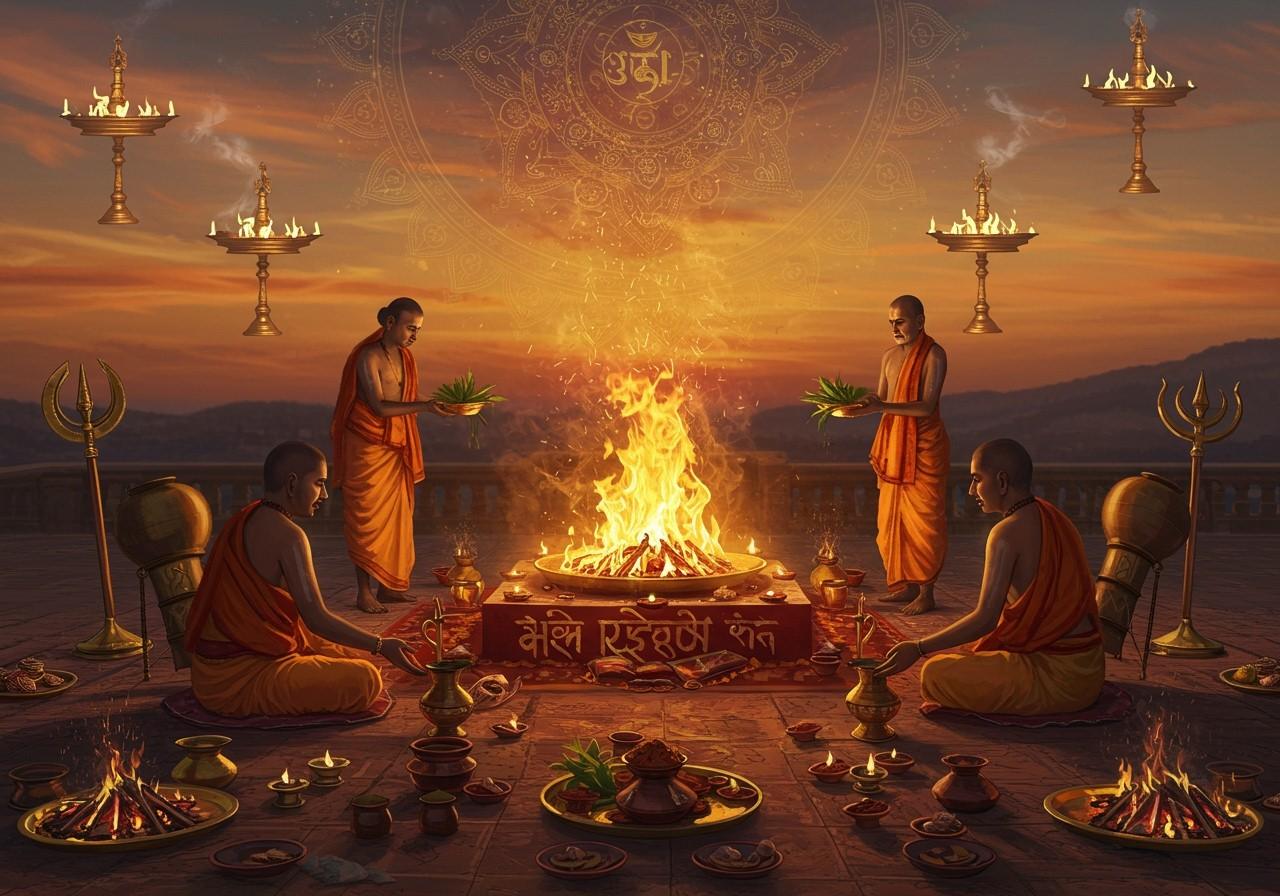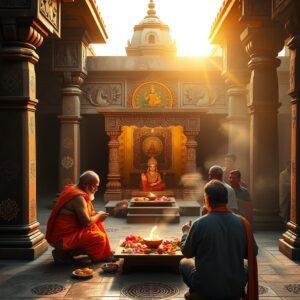
Srauta rituals and traditions are deeply woven into the fabric of Vedic culture, representing a profound connection to India’s spiritual and cultural heritage. Originating around 1500 BCE with the Indo-European-speaking peoples who migrated to India, these ancient practices, derived from the Vedas, encompass a diverse array of rituals and sacrifices meticulously preserved through generations. For culturally rooted Indians who value tradition and authenticity, understanding these practices offers a meaningful link to their ancestral past and the enduring wisdom of the Vedas. Rituals play a crucial role in connecting with the divine and maintaining cosmic order (often facilitated by priests known as purohits), and despite India’s incredible diversity, elements of Vedic rituals, like the fire sacrifice (yajña or homa) and the Hindu rite of initiation (upanayama), continue to unify various aspects of Hindu life.
Understanding Srauta Rituals
Srauta rituals are elaborate ceremonies detailed in the Vedas, particularly within the Brahmanas and Aranyakas. These rituals involve intricate procedures and a variety of sacrificial offerings. The term ‘Srauta’ originates from ‘Shruti,’ meaning ‘what is heard,’ referring to the divine revelations received by ancient sages.
- Role of Yajna (sacrifice): Yajna, or sacrifice, is a cornerstone of Srauta rituals, playing a vital role in maintaining cosmic balance and order. It represents an offering to deities and cosmic forces, fostering a connection between the human and divine realms.
- Types of Srauta sacrifices: Several types of Srauta sacrifices exist, each with its unique purpose and significance. Examples include Agnihotra (a daily fire offering), Soma sacrifice (involving the extraction and offering of Soma juice), and Rajasuya (a royal consecration ceremony).
- Fire deity Agni: Agni, the fire deity, holds a central position in Srauta rituals. Fire symbolizes purity, transformation, and the connection between the earthly and heavenly realms.
- Mantras: Precise recitations of mantras, as prescribed in Vedic texts, are integral to Srauta rituals. These mantras are believed to invoke specific energies and deities.
- Multiple priests: Srauta rituals often involve multiple priests, each with specialized roles and expertise, ensuring the proper execution of the complex ceremonies.
- Sacrificial materials: Specific materials, such as clarified butter (ghee), grains, and the sacred Soma plant, are used in Srauta sacrifices, each holding symbolic meaning.
- Spiritual and philosophical underpinnings: Srauta rituals reflect the Vedic worldview of interconnectedness and cosmic harmony, emphasizing the relationship between humans, deities, and the natural world.
Srauta Traditions
Srauta traditions have been meticulously preserved through oral transmission and written documentation, reflecting the continuity and adaptation of Vedic practices over millennia.
- Historical evolution: Srauta traditions have evolved over time, adapting to changing social and cultural contexts while retaining their core principles.
- Geographical spread: While rooted in ancient India, Srauta traditions exhibit regional variations across the country, reflecting the diversity of local customs and interpretations.
- Preservation of Vedic knowledge: The preservation of Vedic knowledge, including Srauta traditions, has been a continuous effort, passed down through generations of scholars and practitioners.
- Shrauta Sutras: Ancient manuals known as Shrauta Sutras provide detailed instructions for performing Srauta rituals, ensuring the preservation of these complex practices.
- Socio-political impact: Srauta rituals have historically played a role in socio-political contexts, particularly in royal ceremonies and community events.
- Vedic schools (Gurukuls): Traditional Vedic schools, known as Gurukuls, have been instrumental in maintaining Srauta traditions and transmitting Vedic knowledge.
- Contemporary relevance: Srauta rituals continue to be practiced in contemporary times, both in personal and community settings, adapting to modern lifestyles while retaining their core essence.
Srauta Sacrifice
Sacrifice forms the core of Srauta rituals, symbolizing a profound act of offering to deities and cosmic forces. Srauta sacrifices encompass various forms and purposes, each imbued with specific significance.
- Concept of ‘Yajna’: The concept of ‘Yajna’ encompasses a multifaceted role in Srauta rituals, representing not only the act of offering but also the transformative process of purification and connection with the divine.
- Major Srauta sacrifices: Among the major Srauta sacrifices are the Ashvamedha (horse sacrifice), a grand royal ceremony symbolizing power and prosperity, and the Vajapeya (drink offering), associated with strength and vitality.
- Symbolic meanings: Different offerings within Srauta sacrifices hold specific symbolic meanings, representing different aspects of the cosmos and human experience.
- Ritual purity and preparation: Maintaining ritual purity and meticulous preparation are essential for the proper execution of Srauta sacrifices, ensuring their efficacy and spiritual significance.
- Community participation: Large-scale Srauta sacrifices often involve community participation, fostering a sense of collective devotion and shared spiritual experience.
- Spiritual benefits (punya): Performing Srauta sacrifices is believed to accrue spiritual merit (punya), contributing to positive karmic outcomes.
- Challenges in preservation: Preserving Srauta traditions in the modern era presents challenges, requiring dedicated efforts to maintain the knowledge and practice of these ancient rituals.
Relevance and Adaptation in Contemporary Times
Despite their ancient origins, Srauta rituals and traditions continue to resonate in contemporary spiritual practices, adapting to modern life while preserving their core essence.
- Modern adaptations: Srauta rituals have undergone adaptations to fit into contemporary lifestyles while preserving the essential principles and symbolism.
- Resurgence among youth: A growing interest in Vedic traditions among younger generations signals a renewed appreciation for these ancient practices.
- Online availability: The availability of authentic ritual items online, such as those offered by Poojn.in, facilitates access for practitioners.
- Role of technology: Technology plays a role in documenting, preserving, and disseminating knowledge about Srauta rituals, making them accessible to a wider audience.
- Globalization impact: Globalization has influenced the practice and perception of Srauta rituals, fostering cross-cultural exchange and understanding.
- Contemporary events: Festivals and events showcasing Srauta rituals contribute to their preservation and promote awareness among the public.
- Cultural promotion: Organizations and individuals dedicated to cultural preservation are actively working to maintain and promote Srauta traditions for future generations.
Poojn.in: Your Partner in Preserving Tradition
Poojn.in, India’s leading online store for cultural and religious goods, is proud to support the preservation of Srauta traditions. We offer a wide selection of authentic products for your Srauta ritual needs:
- Cotton Wicks: Crafted for optimal burning and ritual purity.
- Camlin Fountain Pen Ink: Use this high-quality ink for writing sacred mantras and scriptures.
Explore our extensive collection of puja items and ritual accessories at Poojn.in.


